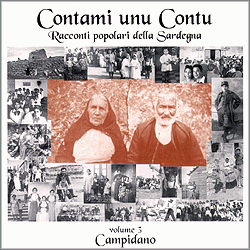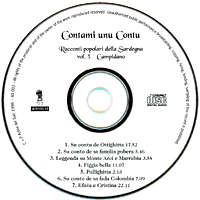

|
Home Page |

|
Go Back |

|
Versione Italiana |

|
Premise |

|
Sound restoration |

|
The Tales |

|
Samples |


|
volume 3
A production of Archivi del Sud |
With this CD which we have entitled "Campidano" we conclude - at least for now - the chain of Sardinian traditional tales called
Contami unu Contu. The term 'Campidano' must be taken in a linguistic rather than geographical sense; the texts of the disc which come from localities which are distant one from the other and belong to the administrations of both Cagliari and Oristano, and are grouped together under the essential criteria that they are told in variants of Campidanese. As for the two preceding CD's
(Logudoro and Baronie), the selection of the tracks was made initially on the basis of the quality of sound and that of the texts of the material possessed; although a large amount of surveying was carried out in the whole area of the Campidanese between 1960 and 1980, only three of the collections made in connection with theses were ceded to the sound archive of the History of Popular Traditions. These belonged to Rita Marras, Filomena Santeufemia and Virginia Tatti. The tales included in this CD come from these collections and document forms and ways of storytelling in Samugheo, Morgongiori, Marrubiu, Terralba, Narcao. As can be seen the localities represented are not many and there are fewer tracks than in the other CD's; however, apart from the limitations imposed by the quality of the recordings, we have privileged the most gifted narrators and therefore those who best document the capacity to keep the attention of the listener alive, to proceed with a long and complex tale, to vary the basic plot by inserting magic and archaic motifs, realistic elements and those which could be found in everyday life.
In this CD the most consistent nucleus is also formed by tales belonging to the category of the magic tale which in Sardinia clearly prevails over other types of narrative.
Figgia bella (TATTI, cat.11; AT 310) is a Sardinian variation of 'The princess in the tower' or 'Rumplestiltskin' as the protagonist is called in the tales published by Grimm. The events develop from the start which is comprised by the pregnant woman who steal vegetables in the garden of the orc , when she is discovered she promises to yield the creature in her womb in order to save herself. The orc arrives to claim his debt when the child begins to go to school and kidnaps her, allowed by the mother, who does not hand over the child personally. W.J. Propp (Le radici storiche dei racconti di fate, Torino, Boringhieri, 1972) finds in this narrative sequence traces of a rite of initiation, in the phase in which children were separated from the mother by "Individuals...dressed as animals or birds" to be led into the forest and segregated; in the fable the segregation of the protagonist is in a tower which can be climbed only by way of her very long hair, as does the prince, who after long trials marries the "figgia bella". The tale, narrated in a pleasant way by Greca Tatti, 80-year-old housewife from Samugheo, was recorded in 1974.
Su contu de Ottighitta (rendered in Italian with 'Sugherina') (MARRAS cat.21) is a variation on the very popular Cinderella story (AT 510 B). The narrator, Raimondo Floris of Morgongiori, eighty at the time of the survey (1074), is capable of holding attention in his telling of the story, and has a good memory despite his age; he possessed a rich repertory of magic fables - a fact demonstrated by other texts he provided which were included in Marras' work. As has been demonstrate by Chiarella Adari in a wide study, the Sardinian Cinderella is the most diffused amongst the magic tales documented in Sardinia and may be found in the two international forms, 510 A (Cinderella) and 510 B (Donkey Skin), both are well-known thanks to the literary re-elaboration of the Grimm brothers, of Perrault and Basile. In Sardinia the tale in the oral tradition displays some peculiarities above all in the 510 B version where the theme of the incestuous father who persecutes the heroine and the disguise of the protagonist with clothes made of cork, hence the name, are of central importance.
Su contu de sa fada Colombìa (MARRAS cat 45) is a fable of magic provided by Carmelina Marras from Marrubiu, a housewife who was 59 in 1974. She reveals herself a good narrator though the conclusion of the tale is rushed. The plot enters the group centring on the search for the lost or supernatural bride (AT 400), but develops in an original way, in particular for the taboo of touching the hair of the fairy-wife. The episode regarding the mother of the winds, documented in other contexts is also interesting; the hero who is in search of his fairy-wife after having broken a rule, arrives at the house of the mother of the winds who leads Tramontana to put the protagonist on the path of the fairy Colombina.
Su contu de sa familia pobera (MARRAS cat 36) is a religious tale (AT 750 B) of the cycle 'Jesus when he was on the earth' which is very widespread in Sardinia. These are simple tales that are linked to the medieval exempla with the goal of moral exemplification, though they are characterised by strong tones of humour that principally focus on the figure of Saint Peter. The narrator, Emma Pilloni, a housewife from Terranova, aged 56 at the time, tells the story with spontaneity and a fresh style, often stopping to focus on the details of the environmental context.
The tone of the legend of Monte Arci and Marrubiu is quite different; the enziologic legend (the foundation of the village of Marrubiu following the abandoning of the village of Monte Arci) is resolved in a tale of dark shades on the search for some treasure guarded by a diabolical serpent and on black masses (MARRAS cat.45; narrator Carmelina Marras, cit.).
Although the plot of Pullighitta (TATTI cat.78) is short and essential, it is a text of particular importance because it is of a type that has been scarcely documented in Sardinia: narrations of this type are characterised by a particular formal structure called 'superimposition' or 'chain-like'. The story of Pullighitta, narrated by Greca Tatti from Samugheo, is based on the motif of the little hen who refuses to lay an egg and the mistress causes other animals and objects to intervene (AT 2030). The plot is constructed by way of the use of a single formula which as the tales proceeds becomes larger and larger, without the addition of other information, which continues until the moment in which a link of the chain is broken: the last to intervene accepts the obligation to act and determines the dissolution of the chain. As Thompson says "the chain-tale never fails to be resolved, by degrees in a long final epilogue, that contains the whole sequence" which alone in sufficient to inform of the contents of the text the value of which lies above all in the ability of the narrator to conclude it without making mistakes.
A long text from Narcao which was narrated in 1974 by Luigia Dessì, a housewife who was 62 at the time (SANTEUFEMIA cat 46) is in a certain way anomalous in comparison to the other texts.
Efisiu e Cristina is not a magic tale and neither is it any other kind of traditional tale - it is the narration of a bloody episode which really occurred at the end of the 19th century. We have included it in this exemplification of forms of the traditional oral tale both because autobiography and the memory of life which has been lived are ever more objects of study by the demo-anthropologist, the social historian and the dialectologist, and also because in our text it constitutes a clear example of how an real event can be transfigured over the years and in the memory of the people, as - in other terms - life becomes legend. The long tale is ever in equilibrium between precise and realistic description and its insertion in an atmosphere of fantasy; in this way, beside the motifs which recall the environment of the
furiadroxus of Sulcis (one may think of the recalling of the activity and family structures, of the funeral mourning, of proverbs), there are also motifs which are typical of the magic tale, of the religious legend, of the novel, of the romantic work (and today we could say the telenovela or soap opera).
The continuous superimposition of archaic elements, fable motifs which are internationally diffused and elements which are more current and typically Sardinian, is typical of the texts which have been chosen, which amongst other things testify to the capacity of the fable and other tales to adapt themselves to new situations which remaining faithful to the traditional structure. A mirror of conservatism, and of evolution but also of the weakening of storytelling and the very language: the structuring of the discourse and the lexicon, as can be seen in particular in the tale from Narcao, oscillate equally in the contents between conservative forms (which today are probably alive no longer) and
Italianisms.
Enrica Delitala
Chiarella Addari Rapallo
University of Cagliari
Annotations on sound restoration
The material restored in this work on the Campidano originally was in a state of good conservation and above all great care had been taken in its recording, furthermore the medium was fortunately found to be in a good state of conservation, despite the fact that these were the cassettes of the first generation, with a quality of magnetising which was far from that of the technological cassettes which we are used to seeing in the supermarket. Nevertheless the cassettes had preserved the warm and harmonious voices with a moving evocative force, the vocal timbres which are difficult to find today. However the inevitable loss of sound information due to the slow demagnetisation over the years has weakened all this.
Returning to the two preceding stages of the restoration of this series Contami unu
Contu, I would like to illustrate in general for those who do not possess the other two volumes of the series and have not read the preceding notes on sound restoration: in our workshop we used the latest computers for multimedia use, on a Mackintosh base: extremely fast and powerful machines that have allowed us, until the conclusion of the project, to work freely and with a certain precision with the large mass of bytes which the programmes of high quality digital editing and the treatment of sound documents necessitated. With the help of the co-workers who were occupied with the restoration in the course of three years, I inputted a large quantity of documents onto the powerful hard disk. These documents did not have the same characteristics of perfection as our modern holders of cyber-memory. They were supported by weak memories attached to fragile magnetic tape, recorded with machines at the dawn of the mass diffusion of domestic recorders, which took place between the 1960's and the 1970's. These machines had reproduction defects and were strictly monophonic, characterised by a persistent and annoying background noise due to the motor for sending the tape forward. The first temptation was to reconstruct the missing parts of the sound signal and to give splendour and presence to those voices, eliminating completely all hums and background noises, in other words to renew following our modern day taste in listening quality, those documents that on the first impression were so unfeasible in a period which seems to have (or believes to have) reached perfection in the reproduction of sound.
I did not give way to this temptation and at a distance of four years from the start of this project I continue to repeat the concept matured over the duration of the work:
conserve those documents with the signs of time without betraying the chronological collocation ( according to the
indications of the International Restoration Sheet in 1972).
Today we can say that the documents restored and conserved in our archive and the CDs of the series have not modified their original characteristic timbre; the intervention was limited to guaranteeing the maintaining of the audio signal as it can come down to us through time.
Finally, at the moment of sending everything to the printer's, another reflection came to us regarding our
work-in-progress: going back into the history of recording, we arrived at the simple conclusion that the listening of these documents had to be transformed from a normal stereophonic listening to a modern CD to the original monophonic state, in this way respecting the medium on which they were recorded and re-listened to by the student researchers of that period. This is the main new factor in comparison to the preceding two CD's.
Here the voyage or adventure of these documents ends for the moment, an affair which started years ago from the voice of a man or a woman, by way of a path made of condensers and transistors in the small portable recorder, then placed on magnetic tapes, transported by car in the winding Sardinian roads and, after the precious work of continual repetition for the realisation of a degree thesis, they were perhaps destined to a sad end: oblivion on a shelf. By accident or for destiny their voyage recommenced c. 30 years later, through new roads made of silicon, microchips, digital circuits, mass memories, all new environments which are aseptic, silent and luminous, almost disturbing, to then arrive on a medium the name of which was unknown to them: the
compact disc, an object of a metallic and shiny colour which permits us to hear their voices daily by way of the imperceptible passing of a light upon its surface, each time we express the desire to hear their voices, to stimulate our imagination and/or the conservation of our language. How strange, it brings to mind....Aladdin's lamp. Ah well! There's nothing strange in that!....After all that is also a tale.
Enzo Favata
Director of sound restoration
The Tales
 Racconti del Campidano
Racconti del Campidano
1. Su contu de Ottighitta (Morgongiori) (17.01)
2. Su contu de sa familia pobera (Terralba) (5.46)
3. Leggenda su Monte Arci e Marrubiu (Marrubiu) (3.58)
4. Figgia Bella (Samugheo) (11.07)
5. Pullighitta (Samugheo) (2.13)
6. Su contu de sa fada Colombìa (Marrubiu) (7.09)
7. Efisio e Cristina (Narcao) (22.11)
Click here for read or listen the track in Real
Audio
![]()